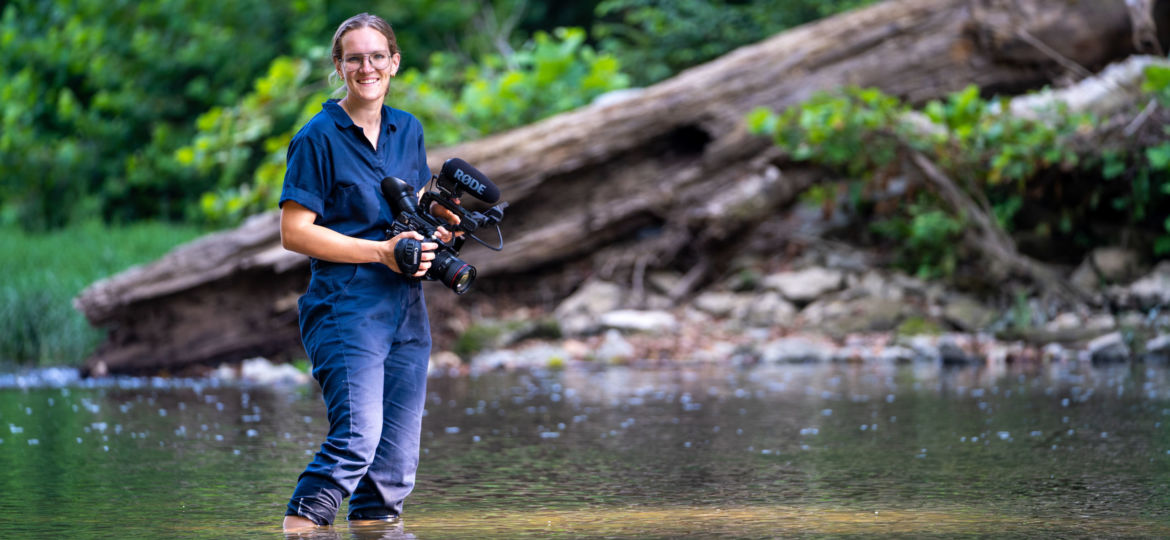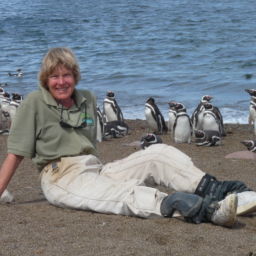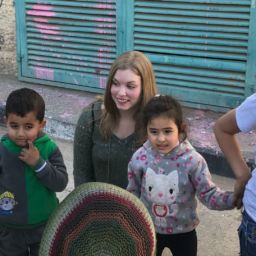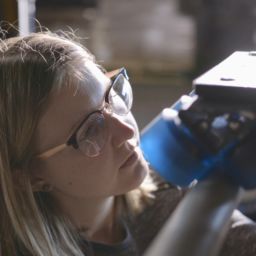
This story is the first installment of a four-part series created in partnership with Hoodox. Indy Maven is proud to be a sponsor of Hoodox’s Women Filmmakers Collection, featuring films directed and/or produced by women.
We often go through life blind to the magic surrounding us: The sunlight peeking from behind the star-like leaves of a sycamore during the morning commute. A pleasant crescendo of birds chirping on a weekend in the springtime. The damp, musty aroma released with each boot strike on a hike through our favorite park. These little moments of wonder can be lost in the mundane and ever-present siren song of the daily grind. So much so that our blissful ignorance can have us blind to the repercussions of our practices.
When organizations advocating for lasting change and preservation for Indiana’s resources need their story told, they often call on the expertise and craft of Katelyn Calhoun and her documentary production company, Teardrop Pictures. Focused on scripting the human journey, Katelyn collaborates with leaders and conservationists to get to the root of their mission and develops a plan to bring the challenge ahead to life, while calling others to act, engage, and support their cause.

“I love stories that are community-driven and heavy on collaboration behind the scenes,” Katelyn says. “Bouncing ideas and building them with another storyteller in creative brainstorming sessions really pumps me up.”
Katelyn’s most recent film, “Hellbender in the Blue,” tells the story of the conservation of the endangered two-foot-long Eastern hellbender salamander in Indiana and the surrounding community working towards improving the health of the river it calls home. An issue otherwise largely unknown, Katelyn’s talent for visual storytelling gives a voice to less familiar—yet no less important—issues.
“I prioritize the community in my work and appreciate it when I see it in other pieces. This can entail telling the story about an existing community or using documentary film as a tool to build or strengthen it,” Katelyn shares.
Katelyn’s recent project list showcases that commitment to her community: Her 2019 film, done in partnership with the Indiana Forest Alliance, “Snag in the Plan,” tells the story of the Northern long-eared bats of Southern Indiana. In 2018, she co-produced a film aiming to inspire people to appreciate the unassuming White River and its importance to Central Indiana’s culture and ecosystem. The captivating film, “Braided with the Current,” was funded by Indiana Humanities and the Nina Mason Pulliam Charitable Trust.
Lovers of film often find themselves in two camps: documentary devotees or mainstream mainstays. Katelyn urges Hoosiers and film-lovers everywhere to take a pause and reconsider giving documentaries a chance, especially those featuring stories close to home:
“The local documentary scene is full of good people that love their community. Hoosiers are humble people who do amazing things. Filming our neighbors and community members is a statement of worthiness. We see ourselves in the characters of a film and so it’s empowering when we share a zip code with the people represented. A documentary film says, ‘We’re human, we make mistakes, but we’re trying our best. Look at the good we can bring to this world.’ Especially in my work with nature and conservation filmmaking, there are beautiful, unknown nooks and crannies in Indiana, and it brings me joy to show off the natural world found in our backyards.”
Documentaries are for everyone, and there’s a place to find them, no matter where you live. Hoodox, a streaming platform for local documentary films produced in, about, and by Hoosiers, can be a great place to start. Katelyn’s first two films have been featured on Hoodox, which exclusively features nonfiction, Indiana-focused content that also aims for viewers to connect with their community and spark positive change. Katelyn is a member of the Board of Directors of Hoodox, and she explains how the service is valuable to her as a filmmaker, as well as to the filmmaking community:
“Hoodox is starting a conversation that will grow to a movement around local, Indiana documentary film. As an independent filmmaker, I’ve come across folks while in the field who don’t believe this is my full-time job. (Frankly, I must pinch myself sometimes, too.) It is invaluable to have a streaming service that not only provides a home for your films, but also legitimizes and expands the imagination of what type of creative work is possible for Hoosiers. Hoodox opens doors and lends credibility to my next film before I’ve even started it.”
The Ball State grad stays busy when she’s not in the field, spending time with her partner Phil and her crazy dog and cat in her home near downtown Indy. In spring 2022, “Hellbender in the Blue” will be on tour with the Indiana Humanities Waterways Film Tour. Keep up with Katelyn and her work as she elevates Indiana’s most important stories and missions on the big screen by connecting with her on Instagram, Facebook, and Vimeo, and read on if you want to know some of Katelyn’s personal favorite flicks and picks.
KATELYN’S TOP PICKS:
All-Time favorite movie: “Amélie”
Best documentary for newbies: “Tig”
Local cinema: Kan-Kan Cinema and Brasserie
Streaming service: Hoodox
Equipment she’d take on a desert island: GoPro, editing laptop, and travel solar panel. “All essentials if given the life-or-death opportunity to make a first-person documentary about what it takes to survive,” she says.
Main photo of Katelyn Calhoun by Winston Garthwaite.
Natalie Derrickson is a communications professional, strategist, and writer who’d love to see the sycamore replace the tulip poplar as Indiana’s state tree. You can connect with her on Instagram, Twitter, LinkedIn, and on her website.
All of our content—including this article—is completely free. However, we’d love it if you would please consider supporting our journalism with an Indy Maven membership.













